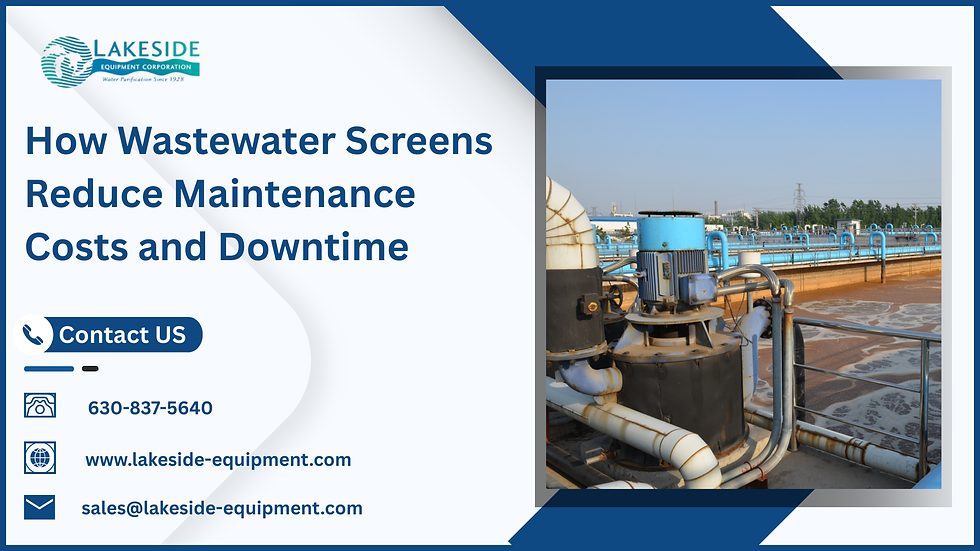How to Upgrade Aging Water Treatment Infrastructure: Modernization Strategies
- lakesideequipment

- Apr 9, 2024
- 3 min read
In today's world, where clean water is increasingly scarce, the importance of water treatment cannot be overstated. Wastewater treatment plays a critical role in ensuring that our water sources remain safe and usable. But as infrastructure ages and populations grow, it becomes imperative to modernize and upgrade existing water treatment facilities. In this article, we'll explore why water treatment is important, how wastewater treatment plants function, and what is an Archimedes screw pump, including the use of technologies like Archimedes screw pumps and wastewater clarification.
Why is Water Treatment Important?
Water treatment is vital for maintaining public health and environmental sustainability. Without proper treatment, wastewater can contain harmful contaminants that pose serious health risks to humans and wildlife alike. Additionally, untreated wastewater can pollute natural water sources, disrupting ecosystems and harming aquatic life. By treating wastewater before it is released back into the environment, we can mitigate these risks and ensure the continued availability of clean water for generations to come.
How Does A Wastewater Treatment Plant Work
Wastewater treatment plants are complex systems designed to remove contaminants from sewage and other wastewater sources. The process comprises of various stages, including:
Preliminary Treatment: In this stage, large objects like sticks and debris are removed from the wastewater to prevent damage to equipment further down the line.
Primary Treatment: During primary treatment, solid particles are settled out of the wastewater using gravity or mechanical processes. This results in the formation of sludge, which can be further treated or disposed of.
Secondary Treatment: Secondary treatment focuses on removing dissolved organic matter and pathogens from the wastewater. This is often done through biological processes, where microorganisms break down organic compounds into simpler substances.
Tertiary Treatment: Tertiary treatment is the final stage of the process, where any remaining contaminants are removed to meet specific water quality standards. This may involve advanced filtration techniques or chemical treatments.
Introducing Modernization Strategies
As water treatment infrastructure ages, it becomes increasingly inefficient and prone to failure. To address these challenges, many municipalities and water authorities are turning to modernization strategies to upgrade their facilities. One such strategy is the use of Archimedes screw pumps.
The Role of Archimedes Screw Pumps
Archimedes screw pumps are a type of positive displacement pump used in water and wastewater treatment plants. They work by rotating a screw-shaped impeller inside a cylindrical housing, which draws water into the pump and pushes it upwards. This design allows for the efficient transfer of water, making Archimedes screw pumps ideal for a wide range of applications, including lifting wastewater for treatment and dewatering sludge.
Harnessing the Power of Wastewater Clarification
Another key modernization strategy is wastewater clarification, which involves the removal of suspended solids and other impurities from wastewater. This process typically utilizes settling tanks or clarifiers, where gravity causes solid particles to settle to the bottom, leaving clearer water at the surface. Wastewater clarification helps improve the efficiency and effectiveness of downstream treatment processes, resulting in cleaner water and reduced environmental impact.

Embracing Innovation in Water Treatment
As populations grow and environmental pressures mount, the need for modernized water treatment infrastructure has never been greater. By investing in upgrades and embracing innovative technologies like Archimedes screw pumps and wastewater clarification, we can ensure that our water treatment facilities remain effective, efficient, and environmentally sustainable for years to come.
In the quest to upgrade aging water treatment infrastructure, collaboration between government agencies, industry stakeholders, and the public is essential. Together, we can pave the way for a future where clean, safe water is accessible to all, preserving not only our health and well-being but also the health of our planet.




Comments